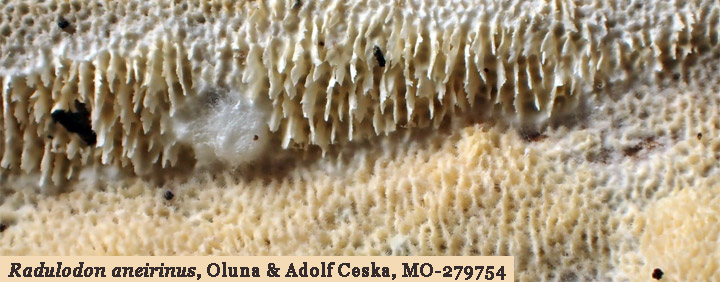
Genus Raduliporus
[was Radulodon and Ceriporiopsis]
This genus was described by Zmitrovich et al. (2006) based on morphology and the apparent isolated position of Polyporus aneirinus, rejecting the previous 2001 placement in Radulodon (now in the Cerrenaceae). The genus was described as monotypic but C. resinascens is related to the type species (Tomšovský et al. 2010, Binder et al. 2013, Zhao and Cui 2014). These two species are very closely related to Trametopsis cervina (Tomšovský et al. 2010, Binder et al. 2013, Justo et al. 2017). The two species are not related to the type species Ceriporiopsis gilvescens, which is in the Meruliaceae.
- Raduliporus aneirina, widespread in Europe and North America on Populus.
- Ceriporiopsis resinascens, (C. pseudogilvescens), Europe and Asia on dead hardwoods; unclear for North America (see note below).
Note: the presence of Ceriporiopsis resinascens in North America is unclear. The only collection on MyCoPortal is from Mississippi. Compare these two accounts (found on MycoBank):
Niemelä. 1985. Mycoflora of Poste-de-la-Baleine, Northern Quebec. Polypores and the Hymenochaetales. Naturaliste Canadien. 112: 450; for C. resinascens:
Causes hard white-rot on standing, dead Salix planifolia, especially in places where branches have fallen off.
Found only once in moist, dense Alnus-Salix thicket.
Baxter [1943] reported C. resinascens from Alaska and Wyoming.
Ryvarden and Gilbertson. 1993. European polypores. Part 1. Synopsis Fungorum. 6: 201; for C. resinascens:
An Eurasian species, not recorded in Japan and North America; its eastern limit in Siberia is unknown.
The species is usually easy to recognize late in the season when the pale brown brittle tube layer contrasts strongly with the white floccose margin. The pores are smaller and the spores more narrow than in C. aneirina which seems to be the closest relative.
Taxon Details and Links
- Nomenclature
-
- Raduliporus , Mycena 6: 24 (2006). Type: Polyporus aneirinus Sommerf., Supplementum florae lapponicae: 278 (1826).
- Taxonomy
- Of existing names, the genus Raduliporus is the only one available for the placement of these two species, so it may be amended to include C. resinascens. Further molecular work may find other related species.
- Related links
- Binder, M., A. Justo, R. Riley, A. Salamov, F. Lopez-Giraldez, E. Sjökvist, A. Copeland, B. Foster, H. Sun, E. Larsson, K-H. Larsson, J. Townsend, I. V. Grigoriev, and D. S. Hibbett. 2013. Phylogenetic and phylogenomic overview of the Polyporales. Mycologia 105(6): 1350-1373. DOI: 10.3852/13-003
- Justo, A., O. Miettinen, D. Floudas, B. Ortiz-Santana, E. Sjökvist, D. Lindner, K. K. Nakasone, T. Niemelä, K.-H. Larsson, L. Ryvarden, D.S. Hibbett. 2017. A revised family-level classification of the Polyporales (Basidiomycota), Fungal Biology 121(9): 798-824. DOI: 10.1016/j.funbio.2017.05.010 [PDF available at Justo Publications]
- Tomšovský M., A. Menkis, R. Vasaitis. 2010. Phylogenetic relationships in European Ceriporiopsis species inferred from nuclear and mitochondrial ribosomal DNA sequences. Fungal Biology 114(4): 350-358. DOI: 10.1016/j.funbio.2010.02.004
- Zhao, C.-L., B.-K. Cui. 2014. Phylogeny and taxonomy of Ceriporiopsis (Polyporales) with descriptions of two new species from southern China Phytotaxa 164(1): 017–028. DOI: 10.11646/phytotaxa.164.1.2
- Zmitrovich I.V., V.F. Malysheva, W.A. Spirin. 2006. A new morphological arrangement of the Polyporales. I. Phanerochaetineae. Mycena 6: 4–56. UDC 582.287.23:001.4.
- Taxon links
- 504896 Raduliporus
- MycoBank
- Index Fungorum